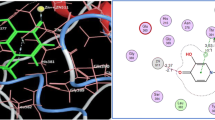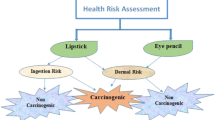Abstract
Medical skin creams (SC) and cosmetic products (CP) specially derived from plants have natural chemicals as ingredients which are a major source of heavy metal releases. Therefore, the presence of harmful heavy metals in these materials is a matter of concern. This study has been carried out to assess the concentrations of heavy metals such as zinc (Zn), iron (Fe), and lead (Pb) in skin creams and cosmetic products that are available in Iraqi pharmacies using atomic absorption spectroscopy. Thirty-three samples from different Iraqi pharmacies of beauty creams, including 13 samples of skin creams and ten samples of cosmetic products. Health risk parameters such as chronic daily intake (CDI), total non-cancer risk (H.I.), and total cumulative cancer risk (TCCR) have been calculated. Based on the results, it is found that the average value of Zn, Fe, and Pb concentrations for SC samples in unit mg/kg were 65.33 ± 14.56, 100.52 ± 21.05, and 2.62 ± 0.64, respectively. At the same time, the average value of Zn, Fe, and Pb concentrations for CP samples in unit mg/kg were 2.30 ± 0.48, 24.18 ± 6.87, and 4.79 ± 1.18, respectively. The results of health risk exposure for SC samples were higher than those for CP samples. But, the values of health risk parameters were within acceptable limits according to Environmental Protection Agency (EPA). Consequently, there is no potential health risk for using medical skin creams and cosmetic products in the present study by Iraqi people.








Similar content being viewed by others
Data Availability
Data generated or analyzed during this study are included in this published article.
References
Weldeslassie T, Naz H, Singh B, Ovens M (2008) Chemical contaminants for soil, air and aquatic ecosystem. In the Modern age environmental problems and their remediation. (pp. 1–22). Springer, Cham https://doi.org/10.1007/978-3-319-64501-8_1
Abojassim AA, Munim RR (2020) Chapter-4 hazards of heavy metal on human health. Research Trends in Multidisciplinary (vol 14). AkiNik Publications New Delhi, p 51
Singirikonda S, Das K, Bhattacharyya S, Khan MS, Singh S (2021) Effect of solvents on metallic and phenolics content in buttercup tree bark vis-a-vis about the anthelmintic activity. Ann Phytomedicine 10(1):96–107. https://doi.org/10.21276/ap.2021.10.1.10
Kumar V, Sharma A, Cerda A (eds) (2020) Heavy metals in the environment: impact, assessment, and remediation (vol 120). Elsevier, pp 109–127
Al-Zurfi SK, Ali BM, Abojassim AA, Albanon RA, Qazmooz HA (2016) Determination of some heavy metals in the blood and milk of nursing mothers: a comparative study between waist and Najaf provinces. Rasayan J Chem 9(3):405–412
Ali H, Khan E (2019) Environmental chemistry and ecotoxicology of hazardous heavy metals: environmental persistence, toxicity, and bioaccumulation. J Chem 6730305. https://doi.org/10.1155/2019/6730305
Rodrigues F, de la Cádiz-Gurrea ML, Nunes MA, Pinto D, Vinha AF, Linares IB, Carretero AS (2018) Cosmetics. In Polyphenols: properties, recovery, and applications. Woodhead Publishing, pp 393–427
Kilic S, Kilic M, Soylak M (2021) The determination of toxic metals in some traditional cosmetic products and health risk assessment. Biol Trace Elem Res 199(6):2272–2277. https://doi.org/10.1007/s12011-020-02357-8
Ullah H, Noreen S, Rehman A, Waseem A, Zubair S, Adnan M, Ahmad I (2017) Comparative study of heavy metals content in cosmetic products of different countries marketed in Khyber Pakhtunkhwa. Pak Arab J Chem 10(1):10–18. https://doi.org/10.1016/j.arabjc.2013.09.021
Mirzadeh MB, Mostafavi G, Kafaei R, Rezvani Ghalhari M, Roof F, Hoseindoost G, Karamali F (2021) Determination of heavy metals in cream foundations and assessment of their dermal sensitivity, carcinogenicity, and non-carcinogenicity. J Environ Anal Chem 1–13. https://doi.org/10.1080/03067319.2021.1873973
Almukainzi M, Alotaibi L, Abdulwahab A, Albukhary N, El Mahdy AM (2022) Quality, and safety investigation of commonly used topical cosmetic preparations. Sci Rep 12(1):1–11. https://doi.org/10.1038/s41598-022-21771-7
Lawi DJ, Abdulwhaab WS, Abojassim AA (2022) Health risk study of heavy metals from consumption of drugs (solid and liquid) samples derived from medicinal plants in Iraq. Biol Trace Elem Res 1–13. https://doi.org/10.1007/s12011-022-03408-y
Matusiewicz H (2003) Wet digestion methods. Sample Prep Trace Elem Anal 241:193–233
Nduka JK, Kelle HI, Ogoko EC (2020) Hazards and risk assessment of heavy metals from consumption of locally manufactured painkiller drugs in Nigeria. Toxicol Rep 7:1066–1074. https://doi.org/10.1016/j.toxrep.2020.08.009
Maher Azmy M (2020) Health risk assessment of heavy metals in selected personal care beauty creams purchased from Egyptian local markets, (phd. thesis) October University for Modern Sciences and Arts
Sahu R, Saxena P, Johnson S, Mathur HB, Agarwal HC (2014) Heavy metals in cosmetics. Centre Sci Environ 2(2):158–164
Liu X, Song Q, Tang Y, Li W, Xu J, Wu J, Brookes PC (2013) Human health risk assessment of heavy metals in soil–vegetable system: a multi-medium analysis. Sci Total Environ 463:530–540. https://doi.org/10.1016/j.scitotenv.2013.06.064
Sharafi K, Yunesian M, Nodehi RN, Mahvi AH, Pirsaheb M (2019) A systematic literature review for some toxic metals in widely consumed rice types (domestic and imported) in Iran: human health risk assessment, uncertainty, and sensitivity analysis. Ecotoxicol Environ Saf 176:64–75. https://doi.org/10.1016/j.ecoenv.2019.03.072
Fakhri Y, Mohseni-Bandpei A, Conti GO, Ferrante M, Cristaldi A, Jeihooni AK, Baninameh Z (2018) Systematic review and health risk assessment of arsenic and lead in the fished shrimps from the Persian Gulf. Food Chem Toxicol 113:278–286. https://doi.org/10.1016/j.fct.2018.01.046
World Health Organization (1998) Quality control methods for medicinal plant materials. WHO Library Cataloguing in Publication Data
Abou-Arab AAK, Abou Donia MA (2000) Heavy metals in Egyptian spices and medicinal plants and the effect of processing on their levels. J Agric Food Chem 48(6):2300–2304. https://doi.org/10.1021/jf990508p
Wu J, Zou Y, Zhan X, Chen S, Lu G, Lai F (2008) Survey of heavy metal pollution in four Chinese crude drugs and their cultivated soils. Bull Environ Contam Toxicol 81(6):571–573. https://doi.org/10.1007/s00128-007-9170-2
EPA, U (2002) A review of the reference dose and reference concentration processes. In Risk assessment forum, U. The Environmental Protection Agency
Author information
Authors and Affiliations
Contributions
All authors contributed equally to the design and conception of the study. Dhuha Jalil Lawi, Waleed Salah Abdul Wahab, and Ali Abid Abojassim performed material preparation, data collection, and analysis. Ali Abid Abojassim wrote the first draft of the manuscript; all authors reviewed the manuscript and approved the final manuscript.
Corresponding author
Ethics declarations
Competing Interests
The authors declare no competing interests.
Additional information
Publisher's Note
Springer Nature remains neutral with regard to jurisdictional claims in published maps and institutional affiliations.
Rights and permissions
Springer Nature or its licensor (e.g. a society or other partner) holds exclusive rights to this article under a publishing agreement with the author(s) or other rightsholder(s); author self-archiving of the accepted manuscript version of this article is solely governed by the terms of such publishing agreement and applicable law.
About this article
Cite this article
Lawi, D.J., abdulwhaab, W.s. & Abojassim, A.A. Potential Health Risks of Zn, Fe, and Pb in Medical Skin Creams and Cosmetic Products Derived from Plants in Iraq. Biol Trace Elem Res 201, 4167–4176 (2023). https://doi.org/10.1007/s12011-022-03493-z
Received:
Accepted:
Published:
Issue Date:
DOI: https://doi.org/10.1007/s12011-022-03493-z




